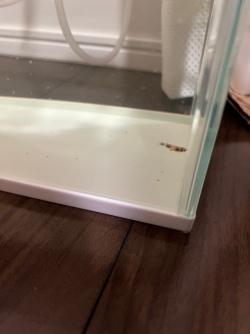confused_aquarist
New Member
It looks like a fat lip from swimming into something. Newly caught rainbowfish get it too from swimming into the glass or jumping and hitting the coverglass.
It could also be the start of Columnaris (mouth fungus) but it doesn't look like that to me. Columnaris is a fast growing bacterial infection that starts off as a white lip and spreads over the face and head within 24-48 hours. The fish usually dies at this stage. If the fish has had the same patch for a few days and it hasn't spread, it's unlikely to be Columnaris.
We use salt with rainbowfish that have a fat lip and it seems to help. You can try it for a week and see if it helps. If not we will need to investigate further. But it's not a normal disease as such and looks more like mucous covering a damaged area (fat lip).
-----------------------
SALT
You can add rock salt (often sold as aquarium salt), swimming pool salt, or any non iodised salt (sodium chloride) to the aquarium at the dose rate of 1 heaped tablespoon per 20 litres (5 gallons) of water. If there is no improvement after 48 hours you can double that dose rate so there is 2 heaped tablespoons of salt per 20 litres.
Keep the salt level like this for 1 to 2 weeks.
The salt will not affect the beneficial filter bacteria, fish, plants, shrimp or snails.
After you use salt and the fish have recovered, you do a 10% water change each day for a week using only fresh water that has been dechlorinated. Then do a 20% water change each day for a week. Then you can do bigger water changes after that. This dilutes the salt out of the tank slowly so it doesn't harm the fish.
If you do water changes while using salt, you need to treat the new water with salt before adding it to the tank. This will keep the salt level stable in the tank and minimise stress on the fish.
When you first add salt, add the salt to a small bucket of tank water (2 litres or 1/2 gallon) and dissolve the salt. Then slowly pour the salt water into the tank near the filter outlet. Add the salt water over a couple of minutes.
Okay. The bumps are internal, and to me the area around it seems bloodshot, where I can see some blood vessels around the mouth area here and there.
Also to my surprise the female killifish with protozoan is responding to metronidazole and has begun to eat! For about 5 days it was floating upside down, but now it's starting to swim again. But there is still some swim bladder issue, it cannot swim down to catch food. I can see that the swim bladder has become very big actually. Because it's so sick that it's translucent. Do you have any idea on how to treat this?


